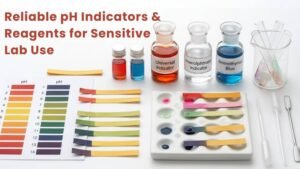pH indicators have been widely used in laboratories and chemical reactions for decades. However, their role in futuristic applications goes beyond simple acidity and alkalinity testing. These versatile compounds are now finding use in advanced industries such as polymers, sustainability efforts, smart materials, cosmetics, healthcare, and sanitation. Their ability to respond to environmental changes makes them valuable in developing new technologies and products that can impact society positively. Let’s explore the futuristic applications of pH indicators in these sectors.
1. pH Indicators in Polymers
- Advanced Materials for Responsive Polymers-pH-sensitive polymers are emerging as a critical material in applications that require environmental responsiveness. These polymers change properties based on pH shifts, making them ideal for drug delivery systems, wound healing, and other biomedical applications.
- Smart Polymers- Using pH indicators within smart polymers allows these materials to react to the local environment. This means they can release drugs in a controlled manner when a change in pH signals a certain condition, such as a disease state or injury.
- Applications in Industrial Manufacturing- In industrial settings, They can be used to monitor polymer production processes where pH-sensitive components are involved. Their inclusion ensures the integrity of materials and optimizes the production of high-performance polymers.
2. Sustainability and Environmental Monitoring
Carbon Footprint Reduction-
pH indicators play a crucial role in sustainability efforts, particularly in reducing the carbon footprint of manufacturing processes. They can be used to monitor environmental conditions, such as water and soil quality, ensuring that industrial activities remain within safe ecological limits.
By embedding them in environmental sensors, industries can monitor pollutants, acid rain, and greenhouse gas emissions in real-time, thus fostering more eco-friendly practices.
Water Quality and pH Sensors-
pH indicators are increasingly being used in water treatment facilities and environmental monitoring systems to assess water quality. They provide real-time data on water pH levels, helping to ensure that water bodies are protected from pollution and other harmful factors.
3. Smart Materials for Future Technology
pH-responsive Smart Materials-
pH indicators are at the forefront of the development of smart materials that can change their physical properties in response to environmental stimuli. These smart materials, embedded with it, are being developed for use in sensors, textiles, and consumer electronics.
For instance, pH-sensitive hydrogels are being developed for wound dressings, where they release medicine only in the presence of infection, signaled by a change in pH.
pH Indicators in Wearable Technology-
Wearable sensors that use pH indicators are also in development. These devices can monitor sweat or skin pH, providing real-time health insights. This technology has potential applications in sports science, healthcare, and even fashion, where garments could change color in response to changes in the wearer’s environment.
4. pH Indicators in Cosmetics and Personal Care
Skincare Formulations-
The cosmetics industry is harnessing the power of pH indicators to create skincare products that adapt to the skin’s changing conditions. They can ensure that cosmetic formulations maintain their stability and effectiveness by altering their pH as needed.
Personalized skincare is becoming more popular, with products tailored to individual skin pH levels. These formulations include pH indicators that help optimize the effectiveness of ingredients, making them more responsive to the skin’s needs.
Color-changing Makeup-
pH-sensitive dyes are also used in color-changing makeup, such as lipsticks or nail polishes that react to the pH of the skin or nails. This offers consumers a unique, personalized experience, with products changing color based on individual pH levels.
5. Healthcare and Medical Applications
Drug Delivery Systems-
pH indicators are finding increasing use in targeted drug delivery systems. Medications can be encapsulated in materials that respond to pH changes, ensuring that they are released only at the specific site of the body that requires treatment. This can lead to more effective treatments with fewer side effects.
For instance, cancerous tissues often exhibit a different pH level compared to healthy tissues. By utilizing pH-sensitive materials, drugs can be released only in the acidic environment of a tumor, minimizing damage to healthy tissues.
Diagnostic Tools-
pH indicators are also used in medical diagnostics to identify changes in body fluids such as blood, urine, and saliva. The use of pH-based diagnostic tools allows for early detection of diseases and conditions, improving patient outcomes.
These tools are also critical in monitoring chronic conditions, where regular pH changes indicate the need for medical intervention.
6. Sanitation and Public Health
Sanitation Products-
pH indicators are used in sanitation products to monitor cleaning effectiveness and ensure hygiene standards are met. For example, pH-sensitive strips can be used to test the efficacy of disinfectants in hospitals, ensuring that surfaces are properly sanitized.
In developing countries, pH indicators can be integrated into simple water testing kits to detect the safety of drinking water, playing a crucial role in public health and preventing waterborne diseases.
Wastewater Treatment-
Wastewater treatment plants use pH indicators to monitor the effectiveness of treatment processes. By adjusting the pH of wastewater, harmful chemicals and toxins can be neutralized before the water is released back into the environment, ensuring compliance with environmental regulations.
Conclusion: The Future of pH Indicators with GSP Chem
pH indicators are proving to be invaluable across numerous industries, from polymers and smart materials to healthcare and sanitation. Their ability to respond to environmental stimuli allows for the creation of advanced materials, personalized products, and innovative technologies that contribute to sustainability, efficiency, and overall quality of life.
GSP Chem, a leading player in the chemical industry, is at the forefront of developing and supplying high-quality pH indicators for these applications. As a brand dedicated to innovation and sustainability, GSP Chem ensures that its products meet the needs of modern industries while contributing to a greener future. Whether for scientific research, environmental monitoring, or healthcare advancements, GSP Chem’s pH indicators continue to drive innovation across sectors.








